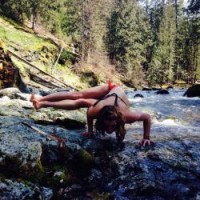Your foot can only feel itself when it feels the weight of your body pressing into the ground.
People have found footprints belonging to the Buddha…
In Sanskrit, Buddhapada.
In Tibet, Rkang pa. རྐང་པ. Foot.
Regarded as archaeological relics, some of these footprints are real and some are fabricated. Some of the footprints have the Dharmachakra in the middle of the sole, and some have auspicious signs engraved in them. Mostly, they are found in rocks—petrosomatoglyphs.
People recreate the Buddhapada in paintings, wood carvings, batik or other artistic formats in order to remember the physical transmission of the Buddha’s teachings. Buddhist legend holds that the Buddha walked and left footprints in every land that his teachings would someday be recognized.
In Sri Lanka, Thailand and Pakistan, the buddhapada are generally engraved in stone and protected in safe places. The footprints are also found in Tibetan thangkas, and the footprints are imprinted on the painting when it is consecrated. The footprint engravings and thangkas are from the anticonic stage in Buddhist art, the time at which statues didn’t exist.
The significance of the footprint carvings or statues is two-faceted: They symbolize the Buddha’s presence, but more importantly, they symbolize his absence. Non-attachment. In order to spread his teachings, he had to go. He had to walk.
The footprint is a familiar image…a simple image. We count in terms of base 10 because we have 10 fingers and 10 toes. Feet represent the concept of being grounded…rooted. But they also symbolize movement, rhythm, transience and kinesthetic stimulation.
As a girl from a rural town in Idaho, I’ve spent a lot of time walking and running. Skiing. Making moves on my feet. Sometimes, there is nothing else to do. And the most beautiful of places in the western United States can often only be reached by foot; you have to walk in order to get to the highest places.
My feet are blistered and knobby, and my toenails are falling off (you saw them at the top of the page). It’s because they have a lot of mileage on them.
I think the sole of the foot is connected directly with the soul of what connects humanity. I’ve spent countless days walking around alone in the hills—sometimes in cowboy boots, mostly in trail running shoes, and sometimes wearing no shoes at all. The dust feels good on bare feet. I could do more productive things with my time, but in a way, wandering is the most productive way to spend a day. I’ve learned more from jaunts in the mountains than I’ve ever learned in school or university. Active meditation, as some would say.
You’ll find prints from my cowboy boots at the top of all the high points in Pocatello and Missoula. They dot the perimeter of all the ridges, too.
I can see all my people from up there. I can feel the sky and the sun.
Communion. Intention. Oṃ maṇi padme hūṃ. ཨོཾ་མ་ཎི་པ་དྨེ་ཧཱུྃ.
You are most conscious when you feel the weight of your own existence connecting to the ground. And you feel that sensation through your feet. Buddhapada.
From Rumi:
“Keep walking, though there’s no place to get to.
Don’t try to see through the distances.
That’s not for human beings. Move within,
But don’t move the way fear makes you move.”
Our very existence is measured in time and space. How far did you go? How long did it take you? How long will it take the Dalai Lama to set foot inside the borders of Tibet again? Where will you go tomorrow on your morning stroll after you drink a beautiful cup of coffee?
Each step is sacred.
Though I don’t walk on mountain ridges in order to reach villages or spread any type of message, those walks are still sacred. I see hawks and bluebirds and butterflies and wildflowers and I feel as if my soul is part of it all. That’s bliss. That’s finding a way to enlightenment in the most simple of formats.
And shouldn’t we measure our lives in terms of the places we went and what happened along the way? That’s how myth is made. That’s what the good stories are made of.
But you have to walk with intention. And it has to be the good stuff—the good intention. Love, passion, effort, work. That’s the good stuff.
Keep walking, even though you may not have any place to go. You’ll find a meaningful journey.
On the drive to town today, I was looking at the sage-covered hills and I thought to myself, “It would take lifetimes to walk all of those ridge lines.”
The Buddha did exactly that—took lifetimes to reach all points of the compass. He’s still doing it. His footprints are still around, and he is still walking. He’ll walk until every being has heard the dharma and felt its power and its peace…its intention. Maybe your path will one day intersect the path of Siddhartha Gautama. And you’ll feel it.
Maybe someday someone will find one of your footprints.
P.S. If you feel like watching a video about monks who run thousands of miles—the greatest non-Olympian athletes—watch this:
Like elephant journal on Facebook
Ed: Brianna Bemel (emailing)
 Share on bsky
Share on bsky





Read 0 comments and reply